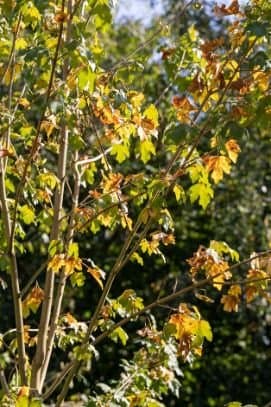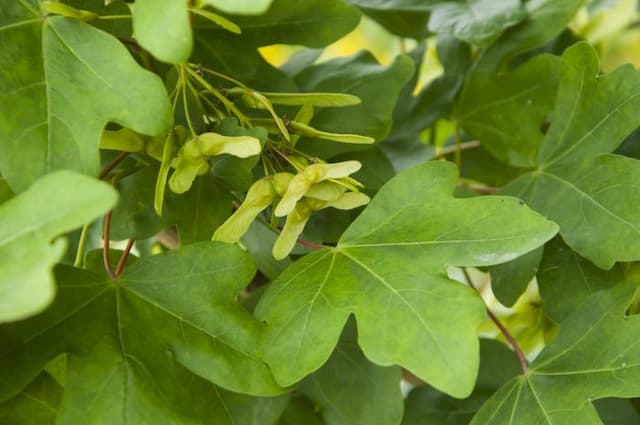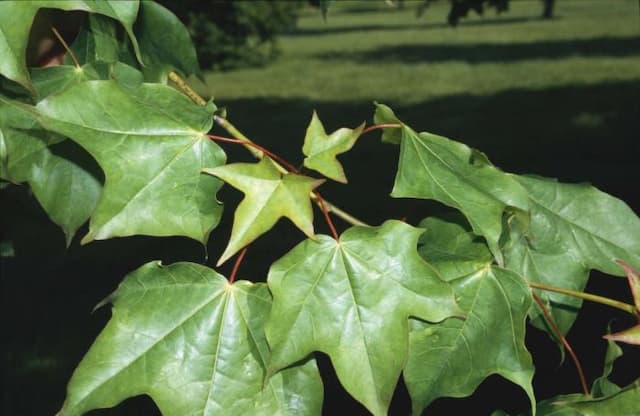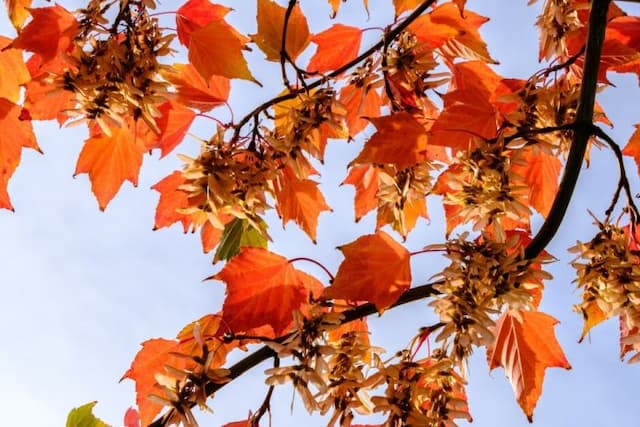Japanese Maple Acer palmatum 'Beni-schichi-henge' (P/v)

ABOUT
The Japanese maple 'Beni-schichi-henge' is a captivating variety known for its stunning foliage and ornamental appeal. Its leaves are the star attraction, flaunting a unique color palette. Each leaf is intricately patterned, with a blend of pink, green, cream, and sometimes hints of orange. The leaves have a distinctive shape with multiple pointed lobes, giving them a palm-like appearance, which is characteristic of Japanese maples. As the seasons change, the leaves of 'Beni-schichi-henge' Japanese maple undergo a magnificent transformation. During the spring and summer, you might observe fresh foliage bursting forth in bright colors, creating a spectacular contrast with more mature leaves. This interplay of hues adds depth to the tree's overall appearance, drawing the eye and making it an exceptional specimen for visual interest in gardens. In autumn, the foliage undergoes yet another change, this time adopting warmer tones. The leaves might take on deeper shades of red or orange, adding a fiery display to the plant's presentation. This seasonal progression ensures that the 'Beni-schichi-henge' Japanese maple remains a focal point in a landscape throughout the year, offering continual visual appeal even as temperatures drop. The branches of this Japanese maple are elegantly arranged, contributing to the plant's sculptural quality. They provide the structure upon which the remarkable foliage can present itself, draping like nature's own art across the tree's silhouette. Overall, the 'Beni-schichi-henge' Japanese maple is a true garden treasure, with its ever-changing palette of colors and its classic, yet distinctive leaf shape. Whether presented as a solo piece or integrated into a broader garden composition, this plant captures the essence of seasonal beauty and the delicate artistry of nature's design.
About this plant
 Names
NamesFamily
Sapindaceae
Synonyms
Beni-schichi-henge Japanese Maple, Harlequin Maple
Common names
Acer palmatum 'Beni-shichi-henge'
 Toxicity
ToxicityTo humans
The Japanese Maple (the common name for Acer palmatum) is generally not considered toxic to humans. There are no widespread reports of poisoning or adverse reactions from ingesting parts of this plant. Nonetheless, as with any non-edible plant, ingestion of large quantities of leaves, seeds, or bark could potentially cause stomach discomfort or irritation due to the natural compounds within the plant that are not meant for human consumption.
To pets
The Japanese Maple is not typically toxic to pets. It is generally regarded as safe for dogs, cats, and horses, with no well-documented cases of poisoning from ingesting parts of this plant. However, individual pets can have unique sensitivities, and consuming non-food plants can sometimes cause mild gastrointestinal upset, such as vomiting or diarrhea, as their digestive systems are not adapted to break down large amounts of plant material.
 Characteristics
CharacteristicsLife cycle
Perennials
Foliage type
Deciduous
Color of leaves
Variegated
Height
6-8 feet (1.8-2.4 meters)
Spread
6-8 feet (1.8-2.4 meters)
Plant type
Tree
Hardiness zones
5-9
Native area
Japan
Benefits
 General Benefits
General Benefits- Decorative Foliage: The Acer palmatum 'Beni-schichi-henge' has uniquely patterned leaves that change color throughout the seasons, providing visual interest and aesthetic appeal.
- Cultural Significance: Known as Japanese maple, this plant is often associated with Japanese gardens and can contribute to culturally-themed garden designs.
- Habitat for Wildlife: Japanese maples can provide shelter and food for birds and insects, thus supporting local biodiversity.
- Shade Provision: With its canopy of leaves, the Japanese maple can offer shade in gardens, reducing local temperature and creating comfortable outdoor spaces.
- Soil Erosion Control: The root system of a Japanese maple can help to stabilize soil and prevent erosion, especially on slopes.
- Seasonal Interest: Throughout the year, the Japanese maple provides a range of colors and textures that add seasonal interest to the landscape.
 Medical Properties
Medical PropertiesThis plant is not used for medical purposes.
 Air-purifying Qualities
Air-purifying QualitiesThis plant is not specifically known for air purifying qualities.
 Other Uses
Other Uses- The leaves of the Japanese maple can be pressed and preserved in books or frames to create natural artwork, capturing the unique variegated patterns of 'Beni-schichi-henge' for decorative purposes.
- Woodworkers and artisans may use the wood from larger Japanese maple specimens to craft small wooden items such as jewelry boxes, emphasizing the wood's fine grain and potential for a polished finish.
- The sap from the Japanese maple can be experimented with as a natural dye for fabrics or paper, potentially yielding unique hues depending on the processing method.
- Japanese maple branches can serve as natural supports for climbing plants in the garden, providing an aesthetically pleasing and functional scaffold.
- Dried leaves of the Japanese maple can be used in potpourri mixes, contributing a subtle woodsy scent and an attractive element to the visual variety.
- During fall, the vibrantly colored leaves can be used to create temporary installation art in outdoor spaces, arranged on the ground or across water features.
- The tree's natural growth pattern can inspire designs and patterns in art and architecture, with its graceful form translated into creative projects.
- With careful pruning, small branches from the Japanese maple may be repurposed as natural, artistic stakes for supporting indoor potted plants.
- Photographers may utilize the Japanese maple as a subject or backdrop for photoshoots across different seasons due to its changing color and structure, offering varied visual interest.
- Leaves from the Japanese maple can be included in educational materials or leaf collections for horticulture programs, showcasing the diversity of leaf morphology.
Interesting Facts
 Feng Shui
Feng ShuiThe Japanese Maple is not used in Feng Shui practice.
 Zodiac Sign Compitability
Zodiac Sign CompitabilityThe Japanese Maple is not used in astrology practice.
 Plant Symbolism
Plant Symbolism- Beauty and Elegance: Japanese Maple, as represented by the Acer palmatum 'Beni-schichi-henge', symbolizes beauty and elegance because of its delicate leaves and the graceful pattern they create.
- Peace and Tranquility: The serene growth habit and soothing appearance of the Japanese Maple's foliage and structure signify peace and tranquility.
- Change and Transformation: The ever-changing leaf color of the Japanese Maple throughout the seasons signifies change and the natural cycle of transformation.
- Endurance and Longevity: Japanese maples are known for their ability to live for many years, symbolizing endurance and longevity.
- Balance: The balanced form of the tree, often used in bonsai, symbolizes harmony and balance in life.
 Water
WaterThe Japanese Maple should be watered deeply about once a week, but this schedule can vary based on weather conditions such as heat waves or droughts, which may require increasing the frequency. Typically, each watering should consist of 10-15 gallons of water to ensure the soil is thoroughly moistened but not waterlogged. During the winter season when the tree is dormant and if precipitation is adequate, watering may be reduced or halted. Always check the soil moisture at about 2-3 inches depth; if the soil feels dry at this depth, it's time to water again.
 Light
LightJapanese Maples prefer a site that offers part shade, especially protection from the harsh afternoon sun, which can scorch their delicate leaves. Morning sunlight with afternoon shade or dappled light throughout the day is ideal for maintaining the health and vibrant colors of their foliage. Avoid deep shade as it can lead to sparse growth and poor leaf color.
 Temperature
TemperatureJapanese Maples are hardy and can tolerate a range of temperatures; however, they grow best when the temperature stays between 60°F and 80°F. They can survive winter cold down to about -10°F but may suffer from frost damage at lower temperatures. Similarly, prolonged exposure to temperatures over 90°F could stress the plant, especially if it's in direct sunlight.
 Pruning
PruningPrune your Japanese Maple to remove dead or crossing branches, which helps maintain its shape and encourages healthy growth. Late winter or early spring, before new growth begins, is the best time to prune. It is recommended to prune lightly every year or two to maintain the desired size and shape, rather than doing severe pruning infrequently.
 Cleaning
CleaningAs needed
 Soil
SoilJapanese Maple prefers well-draining soil with a pH of 5.5 to 6.5. A mix of 1/3 peat, 1/3 pine bark, and 1/3 coarse sand or perlite is ideal for healthy growth and drainage.
 Repotting
RepottingJapanese Maple should be repotted every 2 to 3 years to prevent root-bound conditions and to replenish nutrients in the soil. Younger trees may need repotting more frequently.
 Humidity & Misting
Humidity & MistingJapanese Maple thrives in moderate humidity levels. It does not require high humidity and can usually tolerate the natural outdoor humidity in most temperate climates.
 Suitable locations
Suitable locationsIndoor
Ensure bright, indirect light and protect from hot drafts.
Outdoor
Choose a sheltered spot with dappled shade and protect from harsh winds.
Hardiness zone
5-9 USDA
 Life cycle
Life cycleThe life cycle of Acer palmatum 'Beni-schichi-henge', commonly known as Japanese maple, begins with seed germination, which is usually in the spring following a stratification period where the seeds undergo a cold treatment to break dormancy. The seedlings then establish themselves and start the juvenile phase, producing simple leaves initially before developing the more complex, lobed leaves characteristic of mature Japanese maples. As the saplings grow, they enter the vegetative stage, where rapid growth occurs and the distinctive palmate leaves expand, often showing variegated colors that change with the seasons. After several years, the Japanese maple reaches maturity and enters the reproductive stage, producing small purple or red flowers in the spring, which after pollination, yield samaras (winged seeds) that disperse in the wind. The mature tree will continue to produce flowers and seeds annually while also growing in size and developing a more intricate branch structure. This cycle of flowering and seed production repeats each year until the tree eventually ages, slows in vigor, and enters senescence, leading to the end of its life span which can be several decades long.
 Propogation
PropogationPropogation time
Early spring
The Japanese maple 'Beni-schichi-henge' is most commonly propagated through grafting. This process involves taking a piece of stem with leaf buds, known as a scion, from the desired tree and attaching it to a rootstock, typically from a more vigorous or hardy Acer species. Grafting is usually performed in late winter or early spring before the sap begins to flow. The scion is cut at a slant to match a similar cut on the rootstock and the two are joined together tightly with grafting tape or wax. This process allows the graft union to heal and the scion to receive nutrients from the rootstock, eventually growing into a new Japanese maple that retains the ornamental characteristics of the 'Beni-schichi-henge' cultivar.







![Freeman maple [Autumn Blaze]](/_next/image?url=https%3A%2F%2Fplants-admin.emdemapps.com%2Fimages%2Fplants%2F%2Fimages%2F604b575b84d87.png&w=640&q=75)

